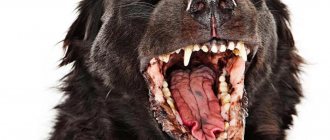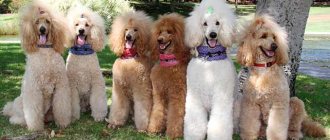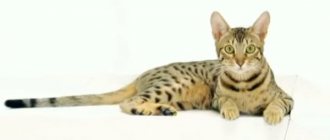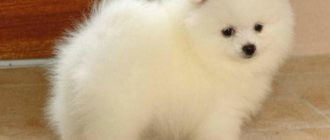History of origin
Most scientists insist that the breeding of the small poodle took place in France, although the supposed countries of origin of this breed also include Hungary and Northern Germany.
This breed was first mentioned in the 1st millennium BC - drawings of dogs resembling poodles . Active breeding of these animals began in the 15-16th century, but the crossing was quite chaotic, so long-haired pointers, griffins and spaniels are noted among the ancestors of small poodles.
NOTE!
In the Middle Ages, many aristocrats considered it their duty to own a poodle, and Queen Marie Antoinette was no exception. It is she who is credited with the authorship of such a haircut for poodles as the “classic lion”.
Over time, the breed gained even more fans, which forced the owners of small poodles to unite into clubs. As a result, in 1886 the first standard was adopted in Great Britain. And already in 1887 the breed was recognized by the American Kennel Club.
In 1936, uniform standards were adopted for all varieties of this breed. Poodles began to be bred en masse in the 60s of the 20th century.
Origin story
Today, many dog handlers argue about where this amazing breed first appeared. Some say that her homeland is undoubtedly France. But others operate on the fact that the name itself has German roots, which means that the homeland of the dogs could well be Germany.
Archaeological finds dating back to the first century BC lead us to believe that the poodle was a pet of high-ranking people in those days.
In the future, it is difficult to trace the path of formation of this species. Dog handlers can only assume that their distant ancestors included a shepherd dog, widespread in Germany and similar in the curly coat.
They also find similarities with the water dog of Italy. Whether this is true or just speculation, we will no longer be able to find out. But is it really that important? The important thing is that the poodle ranks second in Stanley Coren's ranking of the smartest dogs in the world.
In the sixties of the last century, breeders also took care of those who are in love with the curly breed, but are limited in square meters. A small poodle was bred. There are five subspecies in total:
- big,
- small,
- toy poodle,
- dwarf,
- tickap.
Description of the breed
The breed is of medium size, height at the withers does not exceed 45 cm, maximum weight is 12 kg. The body is muscular, lean, the length is almost the same as the height. The withers and croup are almost on the same line.
The paws are placed parallel to each other, the joints are quite strong, and the pads are springy. The tail is located at the level of the waist, and looks up at an oblique angle during movement.
The neck has no dewlap, the scruff is strong, the head is set high. They have an elongated muzzle, the color of the nose depends on the color of the coat.
The ears are placed almost in line with the eyes; according to the standard, their length should reach the tip of the nose. The ears are elongated, slightly rounded at the ends, and covered with hair.
The eyes are located under the frontal lobe, medium in size, almond-shaped, and may have a slight slant. Color ranges from light brown to dark brown.
The coat is medium length with a thick undercoat.
The following coat colors are available:
- white;
- cream;
- beige;
- apricot;
- chocolate;
- black;
- redhead;
- silver
Breed standard
The miniature poodle is harmoniously built and has a proud posture. At the withers, the dog's height reaches 28-35 cm. The weight of an adult is 6-8 kg. According to the standard, the length of the head should be slightly more than 2/5 of the height of the dog. The skull is oval, slightly narrowed towards the nose, with a prominent ridge at the back of the head. The ears are long, wide and rounded at the bottom. The coat is long without undercoat.
The neck is set high and has a slight bend at the nape. There are no bulges or sags in the back. The lumbar region is strong and short. The chest protrudes slightly forward with the anterior edge. The tail is set high. If desired, it can be docked.
View a selection of effective treatments for ear mites in small breed dogs and learn about preventing recurrences.
The characteristics and list of premium dog food can be seen in this article.
Miniature Poodle Shades:
- black;
- white;
- grey;
- apricot;
- brown.
Important! Uneven coloring is considered a breed defect.
Character traits
The Small Poodle is an extremely social animal. They are very friendly, so they do not show aggression towards strangers or other pets without proper reason. The animals are loyal, patient, and playful, which makes them suitable for families with small children. These small poodles are highly intelligent and quick-witted.
Dogs need exercise, so they need to be walked daily. They have excellent memory, which improves the learning process during training. Trying to get the owner’s praise, they involuntarily copy his movements and actions, which makes you think that small poodles have a certain sense of humor.
Despite their friendliness, if the owner is in danger, these dogs become real protectors.
This breed of dog needs constant communication, so if the animal is left alone for a long time, it can get sick from boredom.
Many owners of small poodles note the animal’s highly developed intuition. Because this little pet anticipates what command the owner will give him.
Despite their sociability, these animals cannot be called annoying. They feel when the owner wants to be alone, and try not to cause him unnecessary trouble.
Expert opinion
Kozhevin Semyon Kirillovich
Expert dog handler.
Small poodles are quite sociable and friendly, the only animal with which a pet can have a conflict is a cat, but here, too, everything depends on the breed of the latter. Dogs simply love to play with small children, and they especially enjoy active pastimes, such as playing with a ball in the water. The animals are very obedient, and following commands even gives them pleasure.
Description of the breed and character
The poodle is one of the oldest breeds of decorative dogs, which were originally used for hunting.
But the history of toy poodles comes from Germany, and this breed acquired subsequent development in France. It was there that miniature poodles began to enjoy considerable popularity as companion dogs. During that period, it was customary for the nobility and wealthy people of the Renaissance to take small dogs with them and carry them in the sleeves of their clothes. This is where another name for the breed comes from – the sleeve dog.
Toy poodles are ideal family dogs; they are very cheerful, elegant, energetic, charming, and have a balanced temperament.
Unlike other breeds, the poodle has an excellent memory, which, of course, acts as a clear advantage from a training point of view. At the same time, an obvious disadvantage is the fact that dogs never forget anything.
Advantages and disadvantages
The small poodle dog breed has a number of disadvantages:
- The need for careful pet care. Poodles are among the very clean dogs, so their owner will have to devote a lot of time to keeping their pet clean. In this case, we are talking not only about bathing, but also about cleaning the ears, eyes, and trimming the nails. This also includes regular brushing of your pet and monthly haircuts.
- Requires regular physical activity. The Miniature Poodle is a very active dog and will require daily walks.
- If a cat lives in the house, then conflicts are practically unavoidable.
But all these disadvantages are completely offset by a number of advantages:
- The animals are friendly and loyal. They never attack and practically do not bark at strangers unless they pose a danger to their owner.
- Get along well with small children. They are happy to participate in their games, especially if they involve a ball or require swimming.
- They are highly trainable. Thanks to their good memory and complaisance, animals not only quickly remember commands, but also execute them almost at lightning speed.
- The coat of small poodles is hypoallergenic.
Pros and cons of the breed
With sufficient physical activity, dogs go through an excellent period of adaptation to life, both in urban conditions and outside the city. The dog's fur does not shed, and it does not have an unpleasant specific odor. For this reason, the poodle is one of the few dogs that is suitable for those people who suffer from allergies.
The toy poodle is very clean. Caring for him must necessarily consist of cleaning his ears, teeth, eyes, trimming his claws and a number of other hygiene procedures.
One of the most difficult aspects of keeping this dog is caring for its coat: it must be constantly combed and trimmed. Although for animals that do not take part in exhibitions, there are no special grooming standards. The main condition is convenience for the animal and minimal waste of time and effort for the owner.
For poodles that will participate in various exhibitions, the most common haircuts are decorative. Grooming should be done solely for reasons of attractiveness and convenience of keeping a dog at home. Otherwise, the fur will begin to tangle, forming tangles, which makes the animal look sloppy.
Toy poodles are prone to luxating knee caps. A characteristic congenital pathology is a patent ductus botallus. But in any case, this is an elegant, obedient and friendly animal that has an easy-going character and is easy to train.
With great joy, the top poodle performs various commands. These dogs can often be found in the circus arena. However, even at home, they amuse their owners by performing all sorts of tricks.
The toy poodle loves every member of the family, including children. These animals tolerate loneliness in complete calm. The Tui Poodle is not a noisy dog; it barks very rarely and only for business reasons. Dogs are shy when communicating with strangers, and shyness can also manifest itself in the process of communicating with other dogs.
Appearance and content
Toy poodles have a harmonious, moderately elongated figure. The dimensions of the head are proportional to the dimensions of the body. Dogs have an oval-shaped skull and straight limbs.
The coat of a dog of this breed is quite thick, it is very dense and at the same time lush, there are large and small curls. The coat color can be white or black, gray, peach, brown or golden. On average, the height of a toy poodle is no more than 28 centimeters, weight – up to 3 kilograms.
These small dogs are true long-livers, with an average lifespan of 17 years. With proper care and absence of diseases, a dog can live more than 20 years.
A decorative, indoor animal can live even in a small apartment, but this does not mean that it does not need physical activity. A toy poodle can easily be litter trained, but you still need to walk the dog every day. Small dogs are very active and inquisitive and enjoy running, swimming, playing and exercising.
These dogs practically do not shed. Coat care consists of regular combing and trimming once every 2 months. You can groom the animal yourself or entrust this task to a professional. It is better to bathe your dog no more than once a month. At the same time, the poodle needs to constantly brush its teeth to avoid the formation of tartar.
The Toy Poodle is considered one of the smartest breeds, for this reason training is very easy and fun. Pets quickly and for a long time learn all commands. The main thing in the training process is constant praise and encouragement. However, at the same time, you should not treat the dog as a toy. It must be remembered that the toy poodle is an intelligent, very smart, self-sufficient dog that has a distinct personality.
Feeding and health
It is important that the dog is provided with a complete and balanced diet. The toy poodle can be fed premium ready-made food or natural products. The animal eats little, for this reason we must try to ensure that the minimum amount of food brings maximum benefit.
Food should not be allowed to be very cold or, conversely, excessively hot. With 2 meals a day, it is worth giving fermented milk products at the first meal, but at the second - meat and grated vegetables. At the same time, mixing fermented milk products with meat in one feeding is prohibited.
The food left over after feeding must be removed immediately so that the poodle does not get poisoned by sour food. When carrying out natural feeding, it is necessary to have a mineral supplement containing calcium and phosphorus.
Unfortunately, the toy poodle has a predisposition to various ailments to a greater extent than other dogs. The most common diseases are:
Accepted standard
The standard of the small poodle breed specifies the following characteristics of the animal:
- the length of the muzzle is 9/10 of the length of the entire skull;
- the length of the body is slightly greater than the height of the animal at the withers;
- the head is proportional to the body;
- the width of the skull is less than ½ the length of the head: oval along the longitudinal axis, slightly convex in profile;
- there is a smooth transition from the forehead to the muzzle;
- developed nose, when viewed from the side – vertical;
- lips of medium thickness, the upper one lies on the lower one, but does not overlap it;
- scissor bite;
- eyes – almond-shaped, black or dark brown;
- the ears are long, falling along the cheekbones;
- strong neck with a slightly convex nape line;
- the body is proportional.
Photos of colors
There are several different color variations of small poodles, but the most common colors are:
- Black . Classic color option. The fur of such animals is perfectly black, without brown or gray patches. The skin is gray with a slight blue tint. The nose and claws are black, the eyes are brown.
- White . Quite a common color option. Puppies are born with apricot or cream fur on the chest, ears, and legs, but as they grow older the fur becomes white. Skin is pinkish.
- Apricot . Poodles have coats that come in a variety of shades of apricot, but should not be anything close to dark brown or white. The color of the ears is slightly darker than the rest of the coat. Puppies are born darker, but within 2 years their coat becomes lighter. Eyes – brown.
- Silver . The norm is gray wool, which in its shade is not close to white or black. This coloring is considered complex and takes 2-3 years to form. Puppies are born black, but gradually lighten. Already at the age of 1.5 months, a silvery tint of the muzzle and legs can be observed.
Owner reviews
According to many dog breeders, this is a faithful companion , an obedient student. He is very trainable and understands our speech. He immediately becomes a full member of the family, but at the same time understands his place and follows the established rules. Doesn't smell like dog and practically doesn't shed.
It doesn't even cause allergies. This is a real find for any person, capable of sharing joy, delight and warmth. She will patiently endure any tricks of children, allowing herself to be dressed up and decorated.
The tailed companion will accompany you everywhere and contact your friends with interest. Taking care of it is a troublesome task, but the result is worth it.
Attitude towards children and pets
Small poodles get along well with children and take part in their games with pleasure. Pets are patient, so even if a child hurts the dog a little, it will not bite him.
Regarding relationships with other pets, the poodle gets along well with other breeds of dogs, birds, and rodents.
Relationships with cats directly depend on the breed of the latter, since if the cat does not provoke the poodle into conflict, then they can even become friends.
A toy poodle is a plush little ball.
The Toy Poodle is a very young breed of dog, developed in the last century. He can truly be called the cutest pet. Representatives of this breed look like small plush toys. In general, the prefix “toy” means toy. You want to cuddle them, hug them, and dress them in ridiculous outfits.
The weight of such a poodle is only 3-5 kilograms, and its height is no more than 28 centimeters. That is, these dogs are no bigger than cats. Do not confuse a toy poodle with a toy poodle. The latter is taller than 28 centimeters and weighs from 4 to 6 kilograms.
It is officially believed that the breed was bred on the basis of the standard poodle when the fashion for hunting dogs began in Germany in the 20th century. Standard poodles were designed for hunting. Their ancestors were shaggy herding dogs and the so-called water dogs, which were used to retrieve shot game from reservoirs during hunting.
Now big poodles have already forgotten how to hunt. They are the embodiment of beauty and extravagant decorativeness. The same applies to their representatives. However, toy poodles have not lost the intelligence and learning ability characteristic of large breeds. Unlike toy terriers, small poodles quickly remember the basic phrases of those around them and begin to understand not only commands, but also speech addressed to them. The dog's nervous system is highly sensitive, and it is unacceptable to apply harsh training and punishment to it.
Babies are also very affectionate. Dogs do not tolerate loneliness well, so they should not be left alone in the apartment for a long time. They will definitely spoil something in a fit of sadness. However, this can be avoided if there are two animals (even a cat will do).
One of the advantages of a toy poodle is that it is excellent at litter box training. And they are also long-lived. Their age is on average 16 years.
In the 21st century, the demand for this breed has increased greatly. After all, they have a very kind and cheerful character. The smart kid is very friendly towards his family members and their guests. The little dog gets along well with children of any age. A toy poodle can be an excellent companion for a child in active competitions, provided that he is not tormented or beaten. The pet will always try to please, show devotion and love for the owner.
Despite the fact that the animal is very similar to a toy, you should not treat it that way. He cannot be forgiven for pranks and constantly pampered. Toy poodles, like any dog, require training.
The colors of poodles are varied: white, black, chocolate, silver, red, apricot. The average price for a toy poodle is $500-700.
How to properly care?
Due to the average height of the small poodle, it is quite possible to keep it in an apartment. The main thing is that the pet has its own place. To do this, soft bedding is laid for him closer to the owners’ resting place and away from drafts and radiators.
Representatives of this breed do not shed, but daily brushing is considered an essential part of caring for your pet. These dogs have delicate skin that is prone to irritation, so buy a brush made from natural materials and with soft bristles.
To perform a regular hygienic haircut, you can purchase a machine.
IMPORTANT!
If you want to get a professional haircut of the “lion” or “modern” type, you need to contact a hairdresser.
The ears are regularly inspected, after which their insides are cleaned of dirt using special means. If you have wax plugs, it is recommended to contact your veterinarian.
Small poodles suffer from tearing, so veterinarians advise purchasing special medicinal drops for these dogs.
Dogs' teeth are brushed 2 times a week using a special dog paste. Small poodles are prone to the formation of stones on their teeth, so occasionally you need to take your dog to a professional to prevent the development of an inflammatory process in the oral cavity and prevent tooth loss.
To care for claws, you can purchase nail clippers, trimmers and nail files at any pet store. The frequency of pruning is 2 times a month.
Since dogs have long hair that is prone to getting dirty, the animal is bathed twice a month using special dog shampoos. To dry the wool, it is dried with a hairdryer.
Difficulties of parenting
Like other species of this breed, toy poodles have luxurious coats that will require close attention from the owner.
You should be prepared for regular haircuts, approximately once every 6 weeks, to maintain your pet's coat in its original condition.
In addition to the basic haircut, the toy poodle needs regular trimming of the hair near the tail and on the face.
You should not bathe your dog regularly, but after bathing, you must thoroughly dry it, dry it, and comb its fur to prevent it from becoming tangled.
The toy poodle is prone to frequent barking, so keeping it often becomes a test not only for the owner himself, but also for all his neighbors.
This behavior can be corrected with the help of proper training and regular communication with the pet, but it will still try to warn about the appearance of strangers with its ringing voice.
You should not miss this moment in caring for your pet, otherwise barking may turn into empty babbling, which will also affect the dog’s obedience.
The nervous and sensitive nature of the toy poodle can cause problems in families with small children.
It is difficult for him to tolerate constant noise, and it will be uncomfortable for him to exist in such an environment.
In addition, his vulnerable nature does not tolerate the owner’s dissatisfaction, his elevated tone and reproaches.
Therefore, it is extremely undesirable to adopt a toy poodle into a family where there is discord or loud quarrels are the order of the day.
His timid nature prevents him from quickly getting used to a new environment and a change of owner, so it may take time to adapt.
If the owner stays late at work, or has little time to raise and care for the pet, then one should refrain from purchasing this breed.
Small toy poodles become very attached to people and require regular attention and human interaction.
Otherwise, they become withdrawn and apathetic, losing interest in their surroundings and withdrawing.
Before purchasing a representative of this breed, you should carefully weigh the pros and cons, and also pay attention to the disadvantages of care and the diseases to which small dogs are susceptible.
Life expectancy and illness
How long do small poodles live? The lifespan of these dogs is from 12 to 15 years.
Most often, animals suffer from the influence of fleas and worms. When considering genetic diseases, a predisposition to fusion of the nasal passages is distinguished. The pathology manifests itself in the form of regular snoring and snoring. The problem is corrected surgically.
NOTE!
Congenital pathologies also include a disease such as cleft palate.
In addition, a pet of this breed may suffer from the following diseases:
- diseases of the heart and blood vessels;
- ascites;
- epilepsy;
- postpartum tetany;
- cataract.
Positive
Svetlana, owner of Molly (female, 2 years old) writes:
“The miniature poodle is a breed with which I have been familiar all my adult life. I got my first pet in early childhood – a beautiful gray girl, Jessie. We immediately became friends. She was very smart - she learned easily and happily performed a trick if she knew that the trick would give her a treat.
The dog lived with us for 15 long years and was the favorite of the entire yard - I still remember her with great warmth and love. Now I have a girl, Molly, who is smart, cheerful and terribly cunning. He loves my son and children in general very much, as they do not skimp on treats. An excellent option for a family with children, even in small housing.”
Vladislav, owner of Chuck (male, 5 years old) writes:
“I have owned many dogs, and I have something to compare with. I can confirm - the poodle is the best breed for those who are looking for a dog to participate in sports competitions. Chuck completes all tasks with such ease and mischief that it seems as if this is just entertainment for him.
He mastered many of the tricks himself. For example, if a dog is thirsty, he brings a water bowl in his teeth, and if he is hungry, he brings a food bowl. If the time has come to relieve himself, there is a harness in his teeth. Despite the luxurious fur coat, the dog does not shed or stain the upholstery.”
Oksana, owner of Jenny (female, 6 years old) writes:
“A dog is a big responsibility, especially when there is a baby in the house. Before making my final decision, I read many articles about the best “family” breeds. In the end, my choice fell on a miniature poodle. And I was right - a very soft and loyal creature towards both the child and the cat.
Jenny is incredibly smart and trainable - it’s not for nothing that poodles are taken to the circus to perform! In terms of everyday life, she is unpretentious - from the first days she went to the toilet only for diapers, never chewed furniture and did not bark for no reason. What is equally important is that dogs of this breed do not shed.”
Victoria, Mickey's owner (female, 1 year and 5 months):
“My husband and I are constantly on the move, and so we needed a dog that we could take on trips without any problems. After a long search and comparisons, we got Mickey, a charming little miniature poodle.
She is very quiet and calm - she can easily endure long journeys by car. She loves to dress up, and if she knows we’re going for a walk, she brings her favorite overalls.”
Nutritional Features
The pet’s diet directly depends on the type of feeding; if you plan to use food, you should opt for premium products. These foods contain natural ingredients, mineral and vitamin supplements.
When using natural food, the diet must include the following components:
- lean boiled meat;
- beef or chicken liver;
- boiled eggs;
- kefir and cottage cheese;
- various cereals;
- varieties of fish that do not have bones;
- finely chopped fruits and vegetables.
There are a number of strictly prohibited products:
- fried, spicy, smoked dishes;
- legumes;
- mushrooms;
- sour cream;
- dried grapes with seeds;
- baking
IMPORTANT!
Puppies of this breed are fed 3 times a day; when the dog reaches 8 months, the feeding frequency is reduced to 2 times a day.
Care and maintenance
Poodle care is required on a regular basis and depends on how you would like your pet to look. If you want to stand next to a medalist at international exhibitions, then you have to invest not only your time, but also money in him.
But when we are simply talking about your favorite creature, whose comfort is important to you just as much as your time (and money, respectively), then you can simply cut the entire body short, leaving only luxurious bangs and beautiful ears. Which, however, also need to be combed.
Dogs are prone to allergic reactions, so it is highly recommended not to feed them food from the human table. There are many variations of ready-made food, from the most affordable to premium. Otherwise, you can discuss the diet with your veterinarian.
Approximate daily diet
The diet of small poodles can be varied, but the most optimal option is presented in the table below:
| Eating | Products |
| Breakfast | 100 grams of any porridge (preferably rolled oats) or calcined cottage cheese, 4 crackers, previously soaked in milk. |
| Dinner | 4 tablespoons of chopped meat mixed with 2 tablespoons of vegetables (potatoes, carrots, beets). |
| Dinner | 5-7 tablespoons of shredded chicken or beef mixed with 3 tablespoons of vegetables. |
Types of haircuts
The following popular haircuts for small poodles for boys and girls are:
- Pappy clip . The muzzle is cut short, and the hair on the body and paws is only slightly shortened. The pants have a clear border with a short-cropped foot.
- Under the lion. The muzzle, cheeks and 2/3 of the throat are trimmed to zero. The hair on the hind legs, outer thigh, and groin is trimmed.
- Modern. The fur is completely removed from the face, paws, throat, cheeks and belly.
- Puppy . Almost identical to the modern haircut, but does not create a mane.
- Anglo-Saxon . At the front, the haircut is done in a “lion-like” manner. Hair 1-2 cm long is left on the lower back, groin and rump.
How to cut your own hair?
To groom a small poodle, you need to prepare a number of tools:
- a brush made on a rubber base;
- comb with large teeth;
- Puffer with a soft curve;
- tangle cutter;
- hairdresser's scisors.
The haircut is performed according to this plan:
- Trim after preliminary bathing and thoroughly drying the coat. Before bathing, the animal is combed with a sparse comb and then with a slicker brush. The tangles are sorted out by hand; if they are very dense, then they are trimmed vertically.
- After the wool has dried, the silhouette defined by the standard is cut with scissors.
- A comb is used for periodic combing of wool.
- All parts of the body on which it is necessary to completely remove hair are treated with a machine.
Royal Features
The Royal Poodle is an inquisitive and very intelligent dog that easily and happily learns new commands. He is energetic, cheerful and lively. Such a dog can become a wonderful friend.
However, if the Royal Poodle is not given enough education and training, it can grow up stubborn and headstrong.
Considering that this is a fairly large dog, it can be difficult to cope with him in this case. Important! The Royal Poodle cannot do without the company of people and is ready to accompany its owner to the ends of the earth, just so as not to be separated from him.
These dogs are friendly towards other animals and get along very well with children. But such a pet must be raised exclusively by an adult, since a cunning and resourceful dog very quickly finds weak points in its owners, especially in children, and skillfully manipulates them.
How to choose a puppy?
When choosing small poodle puppies, you need to pay attention to the following points :
- the puppy must be active;
- there is no discharge or traces of shed tears in the eyes;
- there is no rash or redness on the skin;
- there should be no matted fur under the tail, otherwise the puppy will have digestive problems;
- when choosing a bitch you need to look at her character, she is calm, easily makes contact with people;
- the male must be more temperamental and active;
- the mother of the puppies should be calm and not show aggression;
- Documents for animals and their pedigree must be present.
Rules of care
Toy poodles require a lot of attention. It is not limited to appearance care and nutrition. You need to walk your dog at least twice a day. The Poodle needs regular exercise.
Due to their thick fur, animals need to be bathed and groomed periodically. It is better to bathe your dog 3-4 times a month in warm water. Brush the coat daily with a furminator to prevent it from matting or matting. A poodle needs to be trimmed at least once every 1.5-2 months. Be sure to trim the hair around the muzzle to prevent the animal from going blind.
Particular attention should be paid to keeping your pet's ears clean. Wipe them with a cotton oil swab. If this is not done regularly, wax plugs may form, which can cause inflammation in the ears.
Hygienic procedures must be provided from early childhood so that the puppy gets used to them. If you do not train him as a child, an adult poodle will become fussy and fussy when you try to trim his fur or clean his ears.
Nutrition
Your toy poodle needs to be fed a balanced diet. Remove from menu:
- fatty foods
- sweets.
The breed's liver reacts very painfully to improper nutrition. After purchasing a home, puppies need to be fed the food they were given from the breeders. The transition to another food should be done gradually, looking at the dog’s reaction. It is advisable to feed puppies at the same time. From childhood, the animal must get used to the established daily routine.
Look at the characteristics of the pug dog breed and find out the rules for keeping a pet.
What to feed your Yorkshire Terrier? A list of prohibited and permitted products can be seen in this article.
On the page, read about how to properly trim a dog’s nails at home.
In addition to special food, the diet of a toy poodle may include:
- sea fish without bones;
- veal, chicken;
- dairy products;
- eggs;
- rice, buckwheat;
- vegetables (except beans and potatoes).
There should be a bowl of water available for the animal at all times. It is better to place a plate of food not on the floor, but on a stand at the level of the poodle’s chest. After feeding, dishes should be washed immediately.
Nurseries in Russia and the CIS
The following well-known nurseries are distinguished in Russia and the CIS countries:
- "Empire Viktel" - Moscow;
- "Charm" - Moscow;
- “Snowy Lapland” – Moscow;
- “Leggero Dantazori” – Yaroslavl, Novorossiysk;
- “Tender Angel” – Odessa;
- “Sunny Babies” – Krivoy Rog.
The cost of small poodle puppies ranges from 30 to 60 thousand rubles.











